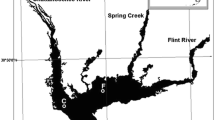Abstract
Recent sediment accumulation rates were measured in Moon Lake, a large (10.1 km2) Mississippi River oxbow lake in northwestern Mississippi. Moon Lake, which receives channeled inflow from an intensively cultivated soybean, rice, and cotton watershed (166 km2) and limited overland flow from surrounding lands, exhibited depositional patterns that were associated with (1) points of inflow, (2) flow patterns, and (3) lake morphology. From 1954 to 1965, 70 percent of the lake bottom experienced accumulation rates greater than 2 cm/yr. Accumulation rates exceeded 4 cm/yr in areas of delta formation. Changes in cropping systems during the 1960s, from cotton to soybeans and rice which require less cultivation, resulted in significantly (a = 0.01) less sediment accumulation during the period 1965- 1982 when 86 percent of the lake averaged less than 2 cm/yr sediment deposition. If current sediment accumulation rates continue, open water habitat in the lake will be reduced by only 3 to 7 percent during the next 50 years.
Similar content being viewed by others
References Cited
Cooper, C. M., E. J. Bacon, and J. C. Ritchie, 1984, Biological cycles in Lake Chicot, Arkansas:In J. F. Nix, and F. R. Schiebe, eds., Arkansas Lakes Symposium, Arkadelphia, Arkansas, p. 48–61.
Fowler, J. M., and E. O. Heady, 1981, Suspended sediment production potential on undisturbed forest land: J. Soil and Water Cons., v. 36, p. 47–49.
Hardy, E. P., Jr., 1978, Environmental monitoring laboratory quarterly summary report and appendix, 1 July 1978: Environmental Monitoring Laboratory Report EML-342. U.S. Environmental Protection Agency.
Pennington, W. R., S. Cambray, J. C. Eakins, and D. D. Harkness, 1976, Radionuclide dating of the recent sediments in Bletham Tarn: Freshwater Biol., v. 6, p. 317–331.
Ritchie, J. C., C. M. Cooper, and J. R. McHenry, 1979, Recent accumulations of sediment in lakes in the Bear Creek watershed in the Mississippi Delta: Southeast. Geol., v. 20, p. 173–180.
Ritchie, J. C., and J. R. McHenry, 1973, Determination of fallout137Cs and naturally occurring gamma-ray emitters in sediment: Int. J. Applied Rad. Isotopes, v. 24, p. 575–578.
Ritchie, J. C., and J. R. McHenry, 1977, The distribution of137Cs in some watersheds in the eastern United States: Health Physics, v. 32, p. 101–105.
Ritchie, J. C., J. R. McHenry, and A. C. Gill, 1973, Dating recent reservoir sediments: Limnol. Oceanog., v. 18, p. 254–263.
Ribinson, A. R., 1971, Sediment: J. Soil and Water Cons., v. 26, p. 61–62.
Author information
Authors and Affiliations
Additional information
Contribution of the Sedimentation Laboratory, Agricultural Research Service, U.S. Department of Agriculture, Oxford, MS 38655
Rights and permissions
About this article
Cite this article
Cooper, C.M., McHenry, J.R. Sediment accumulation and its effects on a Mississippi River oxbow lake. Environ. Geol. Water Sci 13, 33–37 (1989). https://doi.org/10.1007/BF01666569
Issue Date:
DOI: https://doi.org/10.1007/BF01666569




